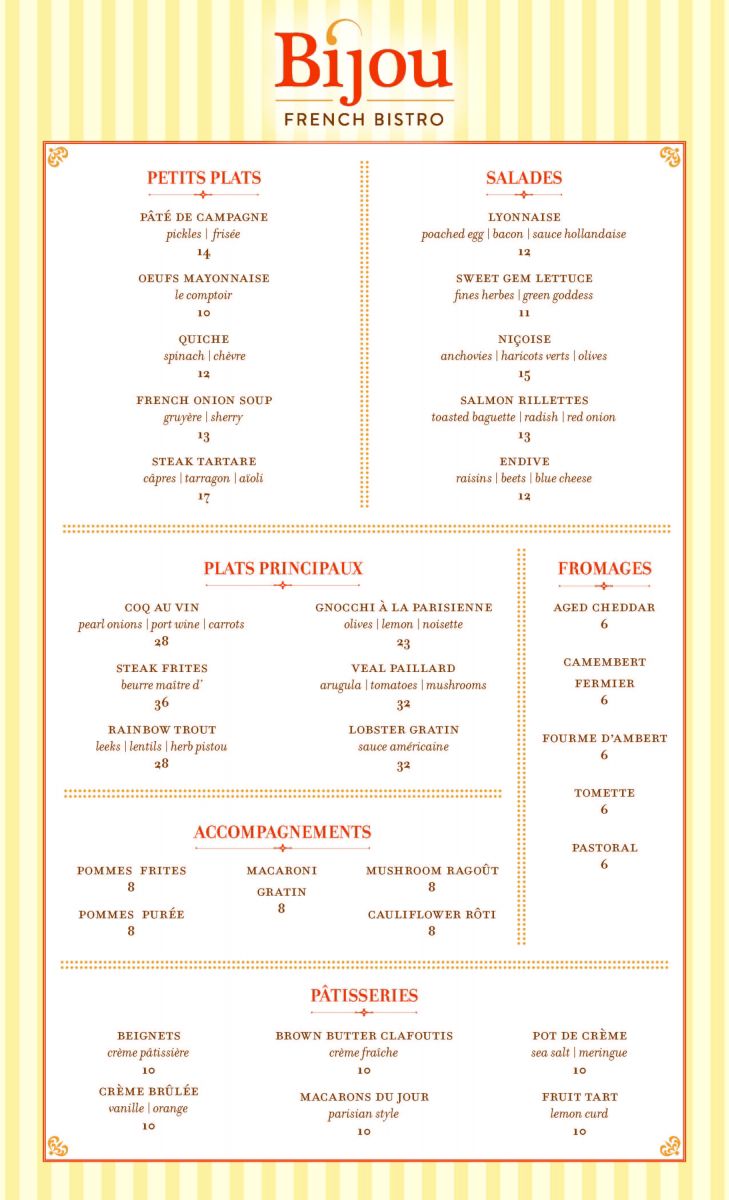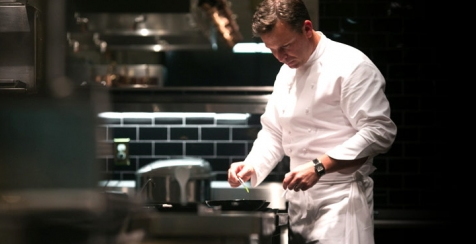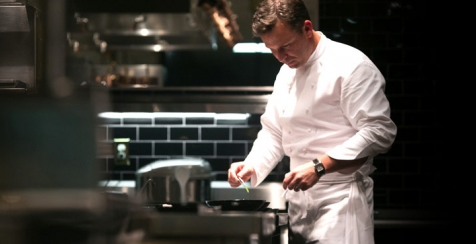William Bradley is coming down from the hills. Or at least his food is. Since 2006 the James Beard-nominated chef has wowed the very high-end clientele at Grand Del Mar’s signature dining room, Addison. Now he’s designed his second menu for San Diego, headed for the more public (thought still very high-end) streets of La Jolla.
The concept is Bijou, a classic French bistro set to open June 27. Bradley’s a historian (he started collecting vintage cookbooks in high school, when most of us were collecting wine cooler labels), and Bijou shows off his old soul.
“We went very, very classic to show some of those old preparations,” says Bradley. “Whenever you go to France, you find yourself in a bistro. It’s the soul of French cooking—it starts with bistro food and then gets refined later.”
Shaun Gethin has been named chef de cuisine for Bijou. Before joining Addison as a sous chef in 2012, Gethin spent time at Gary Danko in San Francisco and Wynn Las Vegas. He and Bradley went through four or five renditions of each dish for Bijou until they got it the way they wanted it. Once open, Bradley will continue to spend most of his time at Addison.
Earlier this year, Grand Del Mar originally put an offshoot of their restaurant Amaya in this space. When that concept didn’t pan out, brass decided to lean on their star to create Bijou.
The result is a menu that reads like a history lesson of French bistros. So I decided to treat it as such with a brief geo-historical perspective of some of the main dishes. You can view the full menu below.
Note: Unless said directly that it’s Addison’s preparation, many of the dish descriptions below are general, classic preps.
PATE DE CAMPAGNE
What’s known as a “country” pate or terrine. Anything with country in the name is simpler, rougher around the edges (more chunks of meat, usually pork shoulder, chicken liver, etc.). Campagne usually only uses a touch of liver, so it doesn’t have that overwhelming organ musk.
OUEFS MAYONNAISE
A bistro classic—basically boiled eggs with designer mayonnaise, which makes it somewhat of a deconstructed deviled egg. “One of my favorite bistros in Paris is Le Comptoir du Relais,” says Bradley. “And this was one of the best dishes I had there. We pay homage to Le Comptoir on the menu.”
FRENCH ONION SOUP
French onion has blue-collar origins as a get-through-the-day meal for laborers in France’s once-famous silk industry. The French didn’t invent onion soup, but they take credit for being good Frenchmen and adding cheese and bread.
STEAK TARTARE
The history of raw, ground meat points to the Mongols who lived on the steppes of Russia. The topography meant animals had to climb and exercise daily—leading to developed muscle and thus tough meat. So the Mongols ground it to make it more tender. French tartare actually has a history of being made with horsemeat, the result of a beef shortage during the Franco-Prussian War in the late 1800s. Bijou’s version will not be equine.
LYONNAISE SALAD
A classic salad found at all the bouchons across France. It’s usually made with frisee, croutons, lardon/bacon and a poached egg on top—so it looks like a birds nest. The bitter greens with the crisp bacon and the runny egg makes a perfectly balanced salad. “We use eggs from Windsor Farm,” says Bradley. “And put a touch of Hollandaise sauce on top of the egg.”
SWEET GEM LETTUCE SALAD
For this salad Bradley will use fines herbes, the classic French herb blend of tarragon, chives, chervil and parsley. Bistros have long used the herb quartet to make omelets and scrambled eggs taste amazing. He’s also topping it with green goddess dressing, created at San Francisco’s Palace Hotel in honor of actor George Arliss, who was starring in a play called The Green Goddess.
NICOISE
A classic salad preparation from Nice, the southern beach city of France. Nicoise has been tweaked a thousand different ways (tuna, lettuce, etc.) But the classic is a tuna-free crudité that, if done right, reeks of garlic, anchovy, olives and tomatoes. It’s a salty blast that couldn’t more perfectly evoke its seaport birthplace.
SALMON RILLETTES
Rillettes are very similar to a pate, only a little rougher. You basically cube your chosen meat, salt it heavily and slowly cook it in a fat until its tender enough to be shredded. They’re traditionally made with pork, so Bradley’s is a twist for the seafood and pilates set (his colleague Thomas Keller makes pretty famous salmon rillettes). There’s usually some sort of alcohol in it (Pernod, whiskey, Cognac, absinthe, etc.). Eat this with a glass of Champagne and hit a new life apex.
COQ AU VIN
You can’t have a French bistro without coq au vin. Julia Child was famous for the classic Burgundy dish. It literally means “rooster in red wine,” since it was created by French farmers to make old rooster meat palatable (the tannins in red wine are a great tenderizer). It’s a fricassee, meaning a slow-braised meat served in its sauce with onions, mushrooms and browned pieces of chicken. True coq au vin was finished with the blood of the rooster and stabilized with brandy and vinegar (which would prevent the blood from clotting).
STEAK FRITES
A fancy name for steak with French fries—found in every French bistro. Usually the cut is a porterhouse, rib-eye or flank, and traditionally pan-fried. The signature crispiness on the shoestring fries is achieved by frying them twice (first at a lower temp to cook them through, then at a higher temp to crisp). “Food that simple has to be so accurate,” says Bradley. “To do steak frites perfectly it takes a lot of concentration.”
GNOCCHI A LA PARISIENNE
Ah, Parisian gnocchi. The lighter, fluffier side of the famous potato dumpling. The secret here is to make an incredibly good pate a choux (cream puff dough). Pate a choux is made with eggs, flour and hot water instead of cold or room-temp water. By adding hot water to flour, you denature the proteins and smash them into little bits. If you’ve had gnocchi that were too dense, the dough was probably made with room temp or cold water. Bradley will serve his with noisette—browned butter, otherwise known as the best flavor on the planet.
VEAL PAILLARD
Paillard is an old French term that’s largely been replaced by escalope. It’s basically a thin veal scaloppine, the meat flattened and then cooked very briefly over a high heat (a grill, or hot skillet).
LOBSTER GRATIN W/ SAUCE A L’AMERICAINE
Lobster a l’Americaine is a traditional brasserie dish believed to have come from Provence. Lobster shells are pounded and scraped, then steeped in a fish veloute and butter so all that great crustacean flavor leeches into the sauce. Tomatoes, garlic, white wine, Cognac, cream and usually tarragon are added to make an incredibly rich ordeal. This dish takes patience, man-hours and dedication, on account of all the pounding, scraping and steeping.

MENU GAWKING: Bijou

PARTNER CONTENT
Chef William Bradley












